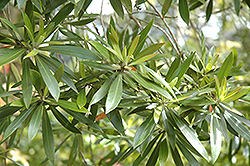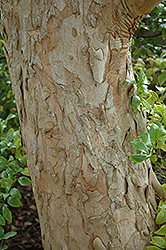It's all about ...
plants

Height: 40 feet
Spread: 20 feet
Sunlight:
![]()
![]()
Hardiness Zone: 8b
Other Names: Kanooka
Description:
A slow growing sturdy tree with a widely spreading canopy; bright yellow flower clusters in summer have what some may consider an unpleasant odor; excellent for street planting and shade; leaves may turn red in colder weather
Ornamental Features
Water Gum features showy clusters of fragrant yellow flowers at the ends of the branches from late spring to early summer. It has green foliage with light green undersides. The glossy narrow leaves remain green throughout the winter. The smooth khaki (brownish-green) bark and brick red branches are extremely showy and add significant winter interest.
Landscape Attributes
Water Gum is an evergreen tree with an upright spreading habit of growth. Its average texture blends into the landscape, but can be balanced by one or two finer or coarser trees or shrubs for an effective composition.
This is a relatively low maintenance tree, and should only be pruned after flowering to avoid removing any of the current season's flowers. It is a good choice for attracting bees to your yard. It has no significant negative characteristics.
Water Gum is recommended for the following landscape applications;
- Accent
- Shade
- Vertical Accent
Planting & Growing
Water Gum will grow to be about 40 feet tall at maturity, with a spread of 20 feet. It has a low canopy with a typical clearance of 3 feet from the ground, and should not be planted underneath power lines. It grows at a slow rate, and under ideal conditions can be expected to live for 80 years or more.
This tree does best in full sun to partial shade. It prefers to grow in average to moist conditions, and shouldn't be allowed to dry out. It is not particular as to soil type, but has a definite preference for acidic soils. It is highly tolerant of urban pollution and will even thrive in inner city environments. This species is not originally from North America.
This plant is not reliably hardy in our region, and certain restrictions may apply; contact the store for more information.

